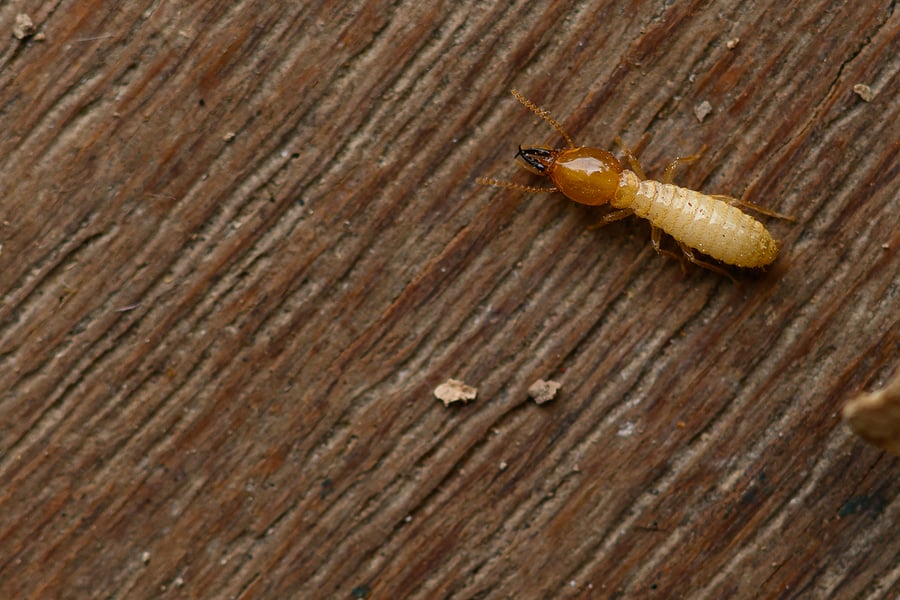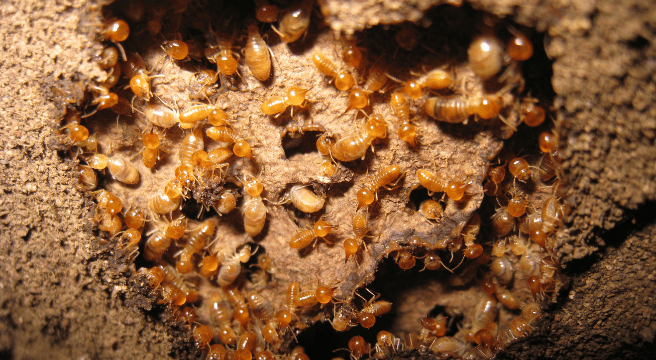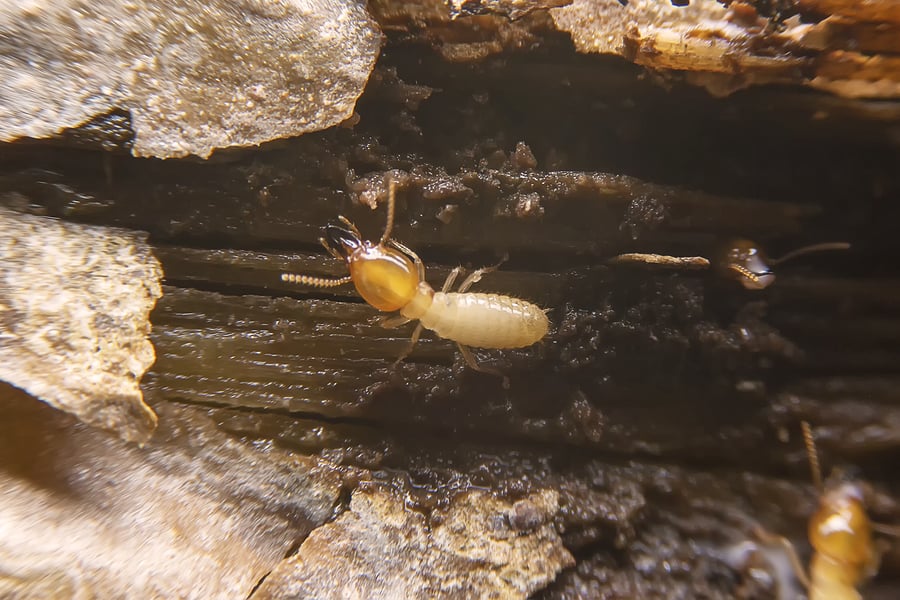READY TO GET STARTED?
REQUEST A FREE ESTIMATE
Fill out the form below or call (888) 466-7849 for a free, no-obligation estimate.

Termites are considered a year-round pest, causing significant destruction to homes and properties each year. Termite swarming season runs from spring to summer for most species. They use this time to reproduce and establish new colonies. Keep your home safe from termites this summer with these termite prevention tips.
Termite inspections aren’t limited to just your house. Make sure to inspect any wooden structures you have outside, as well, like wood furniture, swing sets, and decks. Termites will make small pinholes in the wood they are eating. If you find evidence of termites in your wooden structures, contact a termite control professional immediately. If your structures are not infested, seal them with an outdoor paint or sealant.
Installing a barrier to entry for termites will go a long way towards keeping them out of your home for good. There are two termite treatment options available for the perimeter of your home: bait stations and liquid soil treatments. In addition to these, performing routine inspections of the outside of your home, especially around foundations, is critical. If any gaps or cracks are found, seal or repair them immediately.
Stacks of firewood are an ideal food source for termites. Try not to stack firewood next to your home, shed or garage. Instead, store it several feet away from these structures. You should also elevate it, if possible, on either metal or concrete racks.
It’s important to keep your yard maintained to help prevent termites and other pests. Keep bushes and trees trimmed back so they are not touching your house or overhanging. Remove any dead or dying shrubs from your yard. Try to avoid using wooden mulch; instead, opt for recycled rubber mulch.
Termites don’t take days off so your home is always at risk. They can also go undetected for long periods of time, causing significant damage before you even realize they are there. A pest control professional can perform an annual termite inspection to help spot any signs of termites before they turn into a full blown termite infestation.
If you have a problem with termites or just want to get a head start on prevention, contact your local pest control company for a complete evaluation.
Why Do I Have Ants in My Kitchen?

It’s Termite Awareness Week, and termites are a known threat to southern homeowners. Termites can cause more than 5 million dollars in property damage throughout the United States, and it is normal for this damage not to be covered by homeowner’s insurance policies. Before the damage gets out of control, look for termite signs and consider getting a preventative termite treatment and warranty from professional help.
One of the first signs that termites are near is if you encounter swarmers near your home. Although swarmers do not cause wood damage, they do indicate that a colony is nearby. If you notice swarmers, it’s best to take immediate action and have a local termite control company take a look.
Another tell-tale sign that termites are close by is the presence of mud tubes or tunnels along the foundation of your home. Termites use mud tubes to keep moisture when traveling to and from their colony and your home.
Some other signs of termites that you may notice are:
Even if you do not find signs of termites, now is still the perfect time to get preventative termite protection! With the Sentricon Always Active bait system, you’ll experience 24/7 termite protection, annual inspections, a lifetime termite warranty, and more! Reach out to your local pest control company to help identify the type of termite and recommendations on the best treatment plan.

With the warmer months creeping up on us, it’s time to start preparing for the termite swarming season. Termites cause billions of dollars in damage each year and infestations are normally not found until considerable damage has already been done. It’s important to know what types of termites are active in your area to understand ways to prevent them from causing damage to your home.
The most common type of termite in the southeast is the subterranean termite. This termite species lives in underground colonies with as many as two million members but can also be found in moist, secluded areas above ground. They are the most destructive termite species and, over time, can potentially collapse a building. This is due to their hard, saw-toothed jaws that work like shears and can bite off extremely small fragments of wood, one piece at a time. They typically begin their swarming season in early spring, usually during daylight hours.
Swarming is beneficial when creating new colonies. Termites swarm after a colony has reached a certain capacity and is ready to expand. This normally happens once per year for most colonies. Hundreds or even thousands of swarmers, also known as alates, are produced with the sole purpose of reproduction and expansion.
Swarming can occur indoors or outdoors. They cannot survive indoors because of the lack of soil to colonize. If found indoors, they are usually found near windows and light fixtures as they are attracted to light. Whether indoors or outdoors, they usually can’t cause damage. As swarmers, they can’t bite, sting, or chew. The presence of swarms indicates that a colony is nearby, though; so although the swarmers can’t cause damage, the nearby colony can.
There are many ways to prevent swarming from happening. The first step is to eliminate any termite colonies in the area. To prevent termites, make sure there are no water sources nearby, including standing water around your home. Also, routinely inspect your foundation for loose mortar or bubbling paint to see if there are termites present.
Because a termite swarm indicates a nearby colony, homeowners should take precaution when one is spotted close to home. If you suspect you have a termite infestation, contact a professional local pest control company who can inspect your property and set up a termite control plan.
The first step in termite prevention is to be ready for them. One of the most important things you can do is learn the signs of termites in order to catch them early. Termites can often go undetected for long periods of time, causing significant damage before you are alerted to their presence. The most common types of termites include subterranean termites, drywood termites, and Formosan termites. The type of termite and the location of the infestation help determine the best type of termite treatment to use. Here are four of the most common termite treatments utilized by termite control professionals.
Pretreatments are termite treatments that are performed during the building phase of new construction. It is also preferable to utilize pretreatments when constructing additions on an existing home, as well. Pretreatments are more effective and affordable when utilized before the physical infrastructure of a home or addition is laid. Pretreatments involve a combination of liquid termiticide (commonly containing borates), termite bait, lumber treatment, and in soil barriers.
Barrier treatments form a literal barrier in the ground between termites and your home. A trench is dug around the perimeter of your home and the soil that is removed is treated heavily with a termiticide. The trench is then refilled with the treated soil. In some cases, a physical wall is also constructed inside the outer wall of the trench made up of rock, sand, mesh, and plastic. This adds an additional layer of protection between your home and termites.
Liquid treatments are the most common termite treatments utilized. These treatments are effective for termite infestations on the interior of your home. In these treatments, holes are drilled strategically in both the foundation and the wood. Termiticide is then injected into the holes which forces the termites to emerge. The termites are then exterminated by spot treatments with termiticides.
In these treatments, bait stations containing wood, paper, or cellulose that is laced with termiticide are placed in the ground around your home. Termites are attracted to the bait and eat it. The termiticide is slow acting which allows the termites to return to the colony and spread the bait to others, killing off the entire colony. Bait stations can be used in locations where surface treatments can’t, such as near foundation drains and areas that are covered by slabs or flooring. Bait stations are an effective and long-term treatment solution.
Termites can get out of control quickly and be incredibly difficult to eradicate. If you suspect you have a termite problem, contact your local pest control company for a termite inspection to identify the type of termite and recommend the best course of treatment.
5 Pests That Can Destroy Your Lawn
Why Are Cockroaches So Resilient?

Owning a home is a huge investment and can take plenty of time and energy to maintain the upkeep. Whether it’s your first home or a home you’ve had for years, discovering that it has termites can be unexpected and devastating. Subterranean termites can cause considerable damage to your home’s infrastructure and the cost of repairing it can be in the thousands of dollars. There are two major reasons termites are attracted to your home.
Subterranean termites are attracted to moisture and need an abundant source of it to survive. Improper drainage around the home can often be the major and most common reason these pests have infested. Clogged gutters can cause water to pool up and cause damage to your foundation, making it vulnerable to termite damage. Leaves, twigs, and other debris that fall into gutters can build up, while the excess moisture can soften your roof and cause it to rot. Try to divert rainwater away from your foundation with a down-spot and splash blocks to help prevent the water from pooling. Consider investing in gutter guards to help keep debris and leaves out of your gutters.
Every homeowner is looking to make their home aesthetically beautiful; but often the materials used throughout your yard for landscaping purposes can attract termites. Mulch is commonly used near and around the home, sometimes lying against the foundation. Unfortunately, this material is a major attractant to termites as it can serve as a food source if it retains moisture. Mulch placed near the foundation can lead to these pests residing right at the edge of your home. Instead of mulch, consider using landscaping rocks, or try to minimize the use of wood mulch and keep it at least 15 inches from the foundation.
If you suspect a termite infestation or would like to get ahead of preventing them, consider contacting your local pest control company where they can provide you with the best termite control options for your home.